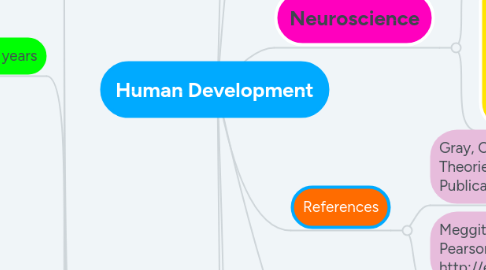
1. Milestones
1.1. Pre-Birth
1.1.1. Social and Emotional
1.1.2. Physical
1.1.2.1. Baby starts to form, heart starts beating and by 40 weeks baby's movement can be felt.
1.1.3. Cognitive
1.1.3.1. Brain development is taking place
1.1.4. Lingustic
1.1.4.1. Mother speaking, singing reading to baby they soon pick up the sounds.
1.1.4.2. Mother speaking, singing reading to baby they soon pick up the sounds.
1.2. 0-3 Years
1.2.1. Social and Emotional
1.2.1.1. Baby forms attachment with parents/carers. Feeling of trust, essential for future relationships
1.2.1.2. Express emotions such as laughs and squeals
1.2.2. Physical
1.2.2.1. Can use arms for support when lying on tummy
1.2.2.2. Starts to crawl, hold on to furniture and walk
1.2.3. Cognitive
1.2.3.1. Start to recgonise routines such as mealtimes, bedtime and bathtime
1.2.3.2. Enjoy repetition of rhymes and request favourite story book
1.2.4. Lingustic
1.2.4.1. Crying, Cooing, Showing Expression
1.2.4.2. One word grows into two words and by 3 years start to become fluent in their extending vocabulary
1.3. 3-6 years
1.3.1. Social and Emotional
1.3.1.1. Become more social
1.3.1.2. Start to understand their feeling, affection and rules much better.
1.3.1.3. Self confident
1.3.1.4. Shows desire to excel and be persistent in learning new skills
1.3.2. Physical
1.3.2.1. Run, jump, climb stairs independantly
1.3.2.2. Swim, ride a bike without stabilizers
1.3.3. Cognitive
1.3.3.1. Solves more complex puzzles
1.3.3.2. Can sustain attention long enough to carry out simple tasks with care and absorption
1.3.4. Lingustic
1.3.4.1. Understands the need for verbal negotiations with peers
1.3.4.2. Begins to 'answer back' to adults when thwarted
1.4. 6-12 years
1.4.1. Social and Emotional
1.4.1.1. Asks many questions
1.4.1.2. Enjoys stories about strong powerful people
1.4.1.3. Self critical
1.4.1.4. Maybe mood and dissatisfied at times but gradually becomes more self reliant and steadier in emotional expressions.
1.4.2. Physical
1.4.2.1. Dresses and grooms self completely
1.4.2.2. Can use tools such as a hammer competently
1.4.2.3. Can sew, paint etc
1.4.3. Cognitive
1.4.3.1. Learns to tell the time
1.4.3.2. Begins to develop concepts of quantity
1.4.4. Lingustic
1.4.4.1. Has ability to reason aloud and to think out ideas, plans and speculate
1.4.4.2. Holds long conversatuons with knowoledge of the need to listen as well as talk and reply with something that is relevent to the topic
1.5. 12-18 years
1.5.1. Social and Emotional
1.5.1.1. Becomes self-conscious
1.5.1.2. Start to spend time alone in own room.
1.5.1.3. Becomes interested in specific hobbies and sports - Tennis, football, gymnastics.
1.5.2. Physical
1.5.2.1. Growth Spurt
1.5.2.2. Start going through puberty
1.5.2.3. Facial hair, voice breaking, pubic hair
1.5.3. Cognitive
1.5.3.1. Reading and writing skills are fluent and skilled
1.5.3.2. Logical reasoning and enjoys discussing and debating
1.5.4. Lingustic
1.5.4.1. Reading with ease and pleasure and can write stories
1.5.4.2. Follows complex directions and instructions without repetition
2. Aspects of Development
2.1. Physical
2.1.1. The development of physical aspects such as fine/gross motor skills, developing of body control and physical coordination
2.2. Cognitive
2.2.1. The way our throught process develops
2.3. Social and Emotional
2.3.1. Involves looking at how children develop and awareness of themselves, how they feel about themselves and others and how they interact in society
2.4. Lingustic
2.4.1. involved development of language and communocation skills and includes verbal and non-verbal communication
3. Nature V Nurture
3.1. Nature
3.1.1. Known as biological factors and genes that determine who we are. Eg looks, height etc
3.2. Nurture
3.2.1. External factors that play a part within life such as the environment that influences us.
4. Theory of Development
4.1. Vygotsky
4.1.1. He believed social interaction with on another and with the factor of imaginative play is a large contributor to process of cognitive development in children. Social interactions helps discover and create meaning.
4.2. Erikson
4.2.1. Theory based on eight stages that focuses on social aspects and conflicts. The stages throughout the theory consist of growth and development throughout infancy to adulthood.
4.3. Bowlby
4.3.1. Attachment is a positive emotional link between babies, young children, parents and careers. First emotional relationship, usually with mother is considers the most important attachment of childhood. This attachment lays foundation for future confidence and security.
4.4. Chomsky
4.4.1. Language is innate, we are all born with the capacity to develop language as it's build into the brain.
4.5. Gardner
4.5.1. Believed that people are not born with all the intelligence they may have and they acquire this throughout life.

